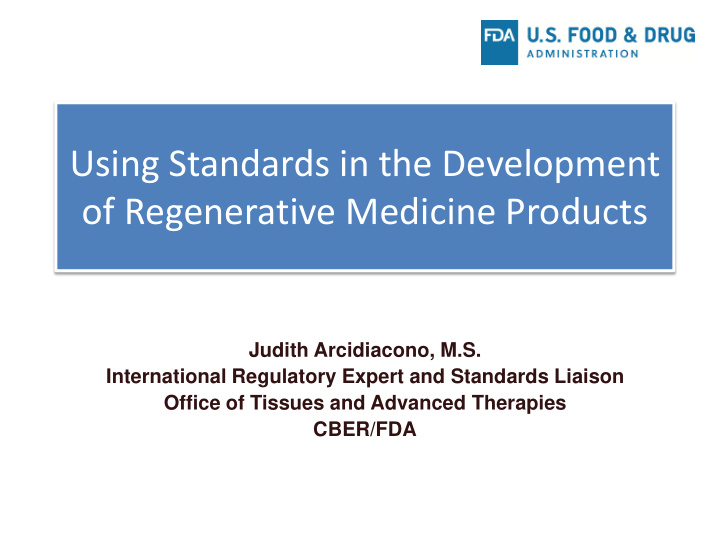



Using Standards in the Development of Regenerative Medicine Products Judith Arcidiacono, M.S. International Regulatory Expert and Standards Liaison Office of Tissues and Advanced Therapies CBER/FDA
Types of Standards Documentary Reference materials standards 2
Documentary Standards • Performance characteristics • Testing methodology • Manufacturing practices • Scientific protocols • Ingredient specifications • Data standards • Terminology/Nomenclature 3
Physical Standards/Reference Materials • Highly characterized reagents that are distributed to assure consistency, quality and safety. • ISO Guide 35 Reference Materials: Material, sufficiently homogeneous and stable with reference to specified properties, which has been established to be fit for its intended use in measurement 4 4
Standards Development Process
Key Principles in Consensus Standards Development 1. Standards respond to a need in the market 2. Standards are based on global expert opinion 3. Standards are developed through a multi- stakeholder process 4. Standards are based on a consensus 6
When should a standard be developed? • Does the base of scientific knowledge on the subject support the development of standardized approaches to methods, testing, etc. ? • Is there consensus among the scientific community that the proposed approaches are appropriate to address the need for standardization? NEED KNOWLEDGE 7
Other Options When Standardization is not Achievable • Standard guides • Terminology • Practices • Guidelines • Publically Available Specifications (PAS) 8
Considerations When Drafting a Standard • What is the scope of the standard? • What is the purpose of the standard? • Who will likely use the standard? • What are the possible intended/unintended consequences of the standard? • How does the proposed standard affect existing work? • Are there similar efforts to develop a specific standard in other standards venues? 9
Considerations for Developing Reference Materials • What is the intended use of the material? • What is the state of the methodology for which the RM will be used? (standardized/validated?) • Who will be likely use the standard? • How will inter-laboratory testing be conducted? • What are the possible intended/unintended consequences of the reference material? • How does the proposed reference material affect existing work? • Are there similar efforts to develop a specific standard in other standards venues? 10
FDA Standards Activities for Regenerative Medicine Products 11
Standards Activities for Regenerative Medicine Products • Staff act as liaisons to Standards Development Organization (SDO) technical committees – FDA researchers, reviewers, and policy makers • FDA/OCTGT Standards Working Group • Workshop sponsorship and participation • Laboratory Programs – Inter-lab round-robin testing (e.g., ISO cell counting, ASTM Demineralized Bone Matrix standard) – Collaborations with NIST (e.g., flow cytometry, viability) 12 12
FDA Standards Workshop Synergizing Efforts in Standards Development for Cellular Therapies and Regenerative Medicine Products (March 31, 2014) sponsored by FDA/CBER/OCTGT http://www.fda.gov/BiologicsBloodVaccines/NewsEvents/Worksho psMeetingsConferences/ucm364114.htm • Inform stakeholders on: 1) The role that Federal Agencies play in standards development; 2) the different types of standards that can be useful in these types of products; 3) identify organizations that are developing standards for such products. 13
Workshop Agenda 1. Government Overview – FDA/CBER, FDA/CDRH, NIH, NIST, NSF 2. Standards Development Organizations – ATCC/ANSI, ASTM, ISO 3. Professional Societies – AABB, ISCT/ARM, TERMIS, USP 4. Case Studies on standards development and standards use in product development 5. Panel Discussion 14
Outcome: Factors Important for Standards Development in the RM Space • Awareness of existing standards- (e.g., mechanism to identify existing standards, a mechanism to allow widespread commenting on draft standards under development by various Standards Development Organizations (SDOs)) • A mechanism to identify the need for specific standards 15
Factors (Continued) • Education on standards development and standards use at scientific conferences, society meetings and universities • Coordination between groups interested in standards development to prevent duplication of efforts • Funding support and scientific interest in developing the needed standards 16
Standards Use to Support Regulatory Applications Submitted to the U.S. FDA
Types of Standards that Can be used to Support a Regulatory Application • Voluntary Consensus Standards (ISO, ASTMi, etc.) • Harmonization Standards o WHO: • Requirements, Recommendations, and Guidelines • Physical Standards for manufacture and control of biological products o ICH • Standards on Quality, Safety and Efficacy • Pharmacopeial Standards (USP, Eur. Ph., JP) 18
OTAT Contact Information Judith Arcidiacono, M.S. International Regulatory Expert, Standards Liaison Judith.Arcidiacono@fda.hhs.gov 240-402-8250 Regulatory Questions: Contact the Regulatory Management Staff in OTAT at CBEROCTGTRMS@fda.hhs.gov or Lori.Tull@fda.hhs.gov 240-402-8361 OCTGT Learn Webinar Series: http://www.fda.gov/BiologicsBloodVaccines/NewsEvents/uc m232821.htm
Recommend
More recommend